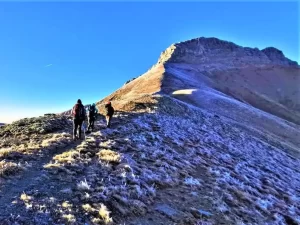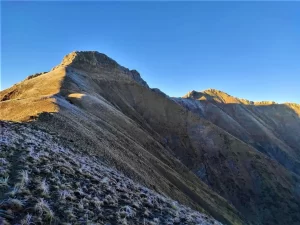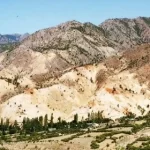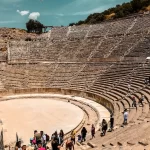Sultan Mountains (Mount Sultandagi)
Sultan Mountains (Mount Sultandagi) are a mountain range located in the central part of Turkey, in the province of Afyonkarahisar. This mountain range is part of the great Taurus Mountains stretching to the south of Turkey.
The Sultan Mountains are about 50 kilometers long and 10 kilometers wide, with their highest peak at 2,610 (8,560 ft) meters above sea level. This region is characterized by steep slopes, rugged terrain and deep valleys that offer magnificent views of the surrounding landscape.
The Sultan Mountains are home to a wide variety of flora and fauna, including oak, pine and juniper forests, as well as various wildlife species such as bears, wolves and eagles. The region is also known for its mineral springs believed to have therapeutic properties.
Historically, the Sultan Mountains were an important trading center with several ancient trade routes running through the area. Numerous ancient ruins and artifacts have been found in the area, including the remains of Roman and Byzantine settlements.
Today, the Sultan Mountains are a frequent destination for nature lovers and nature lovers who offer hiking, camping, rock climbing and skiing opportunities in winter. The area is also known for its natural beauty, and many visitors come to enjoy the scenic views and peaceful surroundings.
Where is Sultan Mountains (Mount Sultandagi) ?
The Sultan Mountains are part of the Taurus Mountains in southern Turkey. For this reason, the mountain forms a natural border between Turkey’s Central Anatolian region and the Mediterranean region. This mountain range is located in Afyonkarahisar province. Afyonkarahisar is a city in western Turkey, located approximately 250 kilometers southwest of the Turkish capital, Ankara.

In which province is Sultan Mountains?
Sultan Mountains also called Mount Sultandagi are located in Afyonkarahisar province in western Turkey. It borders with the provinces of Afyonkarahisar, Kütahya, Uşak, Denizli, Isparta, Burdur and Konya. The city of Afyonkarahisar is located approximately 250 kilometers southwest of Ankara, the capital city of Turkey.
What is the Height of Sultan Mountains (Mount Sultandagi)?
The Sultan Mountains have its highest peak at approximately 2,610 meters (8,560 ft) above sea level. The name of this peak is Gelincikana Hill. There are two more high altitude peaks following it on the mountain. The names of these hills are Toprak Hill and Kırıkkaya Hill. Toprak Hill has an altitude of 2,519 meters (8,264 ft), while Kırkkaya Hill has an altitude of 2,063 meters (6,768 ft).

Sultan Mountains Mountaineering
Sultan Mountains offer various opportunities for mountaineering and nature lovers. Here is some information about mountaineering in the Sultan Mountains:
- Hiking: The Sultan Mountains are a great area for hiking enthusiasts. The mountain offers a variety of trails and routes with varying degrees of difficulty and terrain. There are several hiking trails that lead to the summit of the highest peak, which offer stunning views of the surrounding landscape.
- Rock Climbing: The Sultan Mountains offer a challenging and rewarding experience for rock climbers of all skill levels. Rough terrain and steep slopes provide ideal conditions for climbing. There are several built-in climbing routes in the area that offer a variety of challenges and scenic views.
- Camping: The Sultan Mountains offer several campsites that provide a unique opportunity to experience the natural beauty of the area. Campsites are available in various parts of the mountains, with facilities and amenities such as fire pits, picnic areas, and restrooms.
When planning a mountaineering trip to the Sultan Mountains, it is important to be well prepared and equipped with the appropriate equipment and supplies. It is also recommended that you check the weather conditions and trail conditions before setting off and be aware of any potential hazards or hazards in the area.
Sultan Mountains History
Sultan Mountains have a rich history dating back to ancient times. The mountain has witnessed almost every period of history. For this reason, we can see that the mountain is mentioned from ancient legends to recent events. The characteristics of the mountain according to the periods are listed below.
- Ancient History: The Sultan Mountains were an important trade and trade center in ancient times. Several ancient trade routes connecting Anatolia (modern-day Turkey) to other parts of the world passed through the region. The mountains were also home to many ancient settlements, including Roman and Byzantine towns, as evidenced by the large number of ruins and artifacts found in the area.
- Ottoman Period: During the Ottoman period, these mountains were an important strategic location. The mountains acted as a natural barrier against invasions from the west, and several Ottoman forts and forts were built in the area to protect the area. The Ottoman Empire also benefited from the natural resources of the mountains, such as abundant timber and mineral springs.
- Modern Age: In the 20th century, the Sultan Mountains became an important site for the Turkish War of Independence. The mountains were used as a base by the Turkish National Movement fighting against the Allied occupation of the country. The mountains were also the site of several conflicts between Turkish forces and Greek and Armenian militias.
Today, the Sultan Mountains are a popular destination for nature lovers. The region’s rich historical and cultural heritage is still evident, with some relics found throughout the region that offer a unique glimpse into the region’s past.
Where Does the Name of Sultan Mountains Come From?
In the Battle of Bolybotum (Bolvadin) between the Byzantines and the Seljuks in 1116, the Sultan of the Great Seljuk State, Muizzeddin Melikşah, placed his army on the slope of the mountain in the south, and Emir Mengücek placed his army on the slope of the mountain in the north. Upon this situation, the mountain where the sultan retreated was named Sultan Mountain, and the mountain where Emir Mengücek retreated was named Emir Mountain.
Legend of Sultan Mountains (Mount Sultandagi)
There are several legends associated with the Sultan Mountains, which are an important part of local folklore. One of the most popular legends is the story “The Sultan’s Daughter”. Here is a brief summary of the legend: Legend has it that a sultan’s daughter fell in love with a young man from a nearby village. However, the sultan did not approve of the relationship of his daughter and the young man and forbade them to meet. Determined to be with the sultan’s daughter, the young man climbed to the highest peak of the Sultan Mountains and shouted his love for her. Hearing the boy’s cries, the sultan ordered his soldiers to bring the young man to the palace. The young man was brought before the sultan and ordered to stay away from the sultan’s daughter. Thereupon, the young man refused this offer and was then imprisoned. The sultan’s daughter was very upset about this situation. Then the girl climbed to the top of the mountain and threw herself from the top. Legend has it that the sultan, impressed by his daughter’s self-harm, ordered the young man’s release and allowed the couple to marry. The Sultan Mountains, named after the sultan, became the symbol of the power of love and the power of human feelings with this legend.
Places Near Mount Sultandagi
When you come to the city of Afyonkarahisar, where the Sultan Mountains are located, there are many areas you can visit. Ayfonkarahisar is a city in western Turkey. The city has a rich history and culture. Here are some of the places you can visit in Afyonkarahisar:
Afyon Castle: Afyon Castle is a historical castle located on a hill overlooking the city. The castle dates back to Byzantine times and has been renovated several times over the years.
Afyonkarahisar Archeology Museum: This museum is a great place to learn about the history of the region. It has a collection of artifacts from the Paleolithic period to the Ottoman period.
Ulu Mosque: It is a beautiful mosque located in the city center. It was built in the 13th century during the Seljuk period and has been renovated several times over the years.
Zafer National Park: It is a beautiful park located outside the city. It has hiking trails, picnic areas and a lake where you can go boating.
Ayazini Village: Located outside the city, this village is known for its rock formations and cave houses. You can also visit the ancient city of Hierapolis, which is located nearby.
Hot Springs: Afyonkarahisar is known for its thermal baths and there are many facilities where you can enjoy hot springs and hot springs.
These are just a few of the many places you can visit in Afyonkarahisar.
You can see Sultan Mountains (Mount Sultandagi) Photos on Google Photos
You may also want to learn about Turkey’s highest mountain, Mount Ararat. Please click on the link to read more about majestic Mount Ararat.





